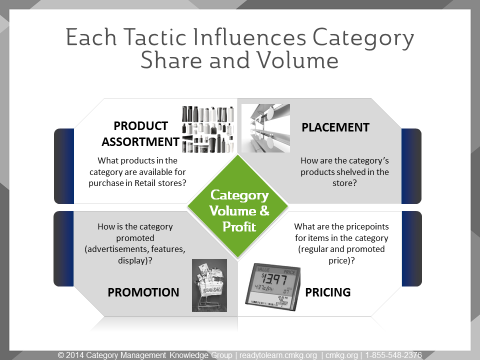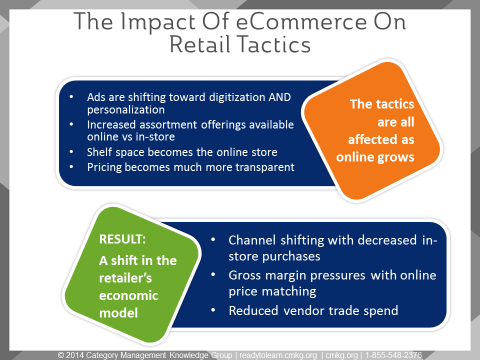Strategy, Insights, Action!
You understand your underlying strategies, you’ve learned how to drill down to derive insights from your data, now what?
Time to create action through the category tactics, or 4 Ps, including Product, Placement, Pricing and Promotion. Begin to develop analytic skills in category tactics by understanding the big picture of Category Tactics & Analytics.
Each tactic influences volume, profit and share within a brand or category, and are the key drivers of “action” in the category. They need to be monitored and analyzed in order to understand how they impact volume growth or decline within a brand or category.
Both Retailers and Manufacturers (including category management, marketing, sales, retail operations, etc.) need to understand how to analyze the category tactics (the 4 Ps) to make the best fact-based decisions and recommendations for the categories they compete in.
Here are some great resources to help you get started in measuring and analyzing the tactics:
- View our “Category Tactics and Analytics” webinar recording
- Check out our accredited, online course on “Category Tactics and Analytics”
- View our “Category Tactics & Analytics” course preview video
3 Reasons to Develop Your Skills in Tactical Analysis:
1. To Make the Best Tactical Recommendations/Decisions for the Business
For Retailers, consider all of the decisions that are made across product assortment, placement, pricing and promotion in your stores. How many of these decisions align with your overall Retailer strategy and target Shopper, and are driven through fact-based analysis? By arming your retail team with the strategies, guidelines and principles across the tactics, and training them on how to analyze each, you are giving them what they need to make the best decisions for your stores based on what you are trying to accomplish as an organization.
For Manufacturers, consider the dollars, resources and time spent on the tactics (including innovation and new product launches, planograms, tradespend and promotional planning …). Are you arming your sales and marketing teams with the skills to analyze the tactics – not only for your brands but for total category and competition? There’s an opportunity to have your organization look at the business through different, more strategic lenses, that consider a bigger picture perspective with a focus on the tactics.
2. To Better Understand What’s Driving Your Business
If you look at a report and see that you lost one share point in your business, what’s the first question you ask? It’s probably “why?”. By integrating the tactics into your scorecards, you can quickly identify whether major changes in your tactics had an impact on your results or what your competition did to drive their results. Let’s review how each of the tactics influences volume and share, and sample measures that can be incorporated into your scorecard as indicators of change in the tactic.
Product Assortment – if the product isn’t available in the store, it means no sales. Strong performing items have a positive impact on share. In many categories, innovation is a key driver for long-term share growth. You can build your strategy behind assortment and space planning with the right measurements.
Sample Measure: # items and % item change by segment
-------------------------------------------------------
Placement – if the product isn’t on the shelf, it means no sales. Positive long-term results are driven by a well-merchandised section where the category is shelved based on best practices for strategic space management & advanced shelving (i.e. the consumer decision tree).
Sample Measure: # linear feet and % change by segment (this is a difficult measure to have on a scorecard because it’s difficult to get this information on an ongoing basis)
-------------------------------------------------------
Pricing – changes in pricing (even by a few cents) can significantly impact volume and profit. It’s commonly used by Retailers and Vendors as a short-term tool to drive volume up with aggressive pricing. Learn to evaluate the key considerations for strategic pricing analysis.
Sample Measure: average tonnage price and % change by segment
--------------------------------------------------------
Promotion – has a high impact on volume with short-term results during the promotional period. It includes in-store display support, and usually ties in with lower prices (or temporary price reductions – TPR). It can be important to get back to the basics to improve promotion effectiveness.
Sample Measure: Share of feature support and % change; share of display support and % change
3. To Better Understand the Omni-Channel Consumer
Development in online sales has a direct impact on a retailer’s tactics. For example, direct mail and newspaper circulars are a diminishing role in retail marketing. Mass advertising will not disappear overnight, but its influence is certainly waning. There are increased assortment offerings in the online space, and shelf space becomes the online store. Pricing also becomes transparent.
The result? These trends will put considerable strain on the traditional retailer’s economic model with challenges to both the top and bottom lines. Gross margins will come under pressure from price transparency (retailers will need to have the same pricing in-store as online to remain competitive). There will be a reduced share of trade spending from vendors. It makes sense that as there is an increased focus in the digital arena; vendors will allocate fewer trade dollars to secure shelf space and run in-store promotions.
Both Retailers and Vendors need to become more strategic in their online approach, and continue to evolve their tactical strategies in this space as they start to better understand the omni-channel consumer.
Looking for more ways to effectively analyze the tactics? Category Management Knowledge Group can help you to move your team to the next level through custom category management training programs.
Check out our accredited course on “Category Tactics & Analytics”, which gives an in-depth understanding of the key tactical measures and how to analyze, derive insights, and create action across each of the 4 Ps.
 |
$125 USD INCLUDES: |





